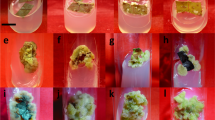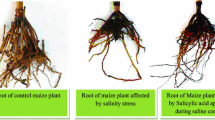Abstract
The induction of hairy root cultures is a useful platform with many merits, making it an attractive system for plant biochemistry and molecular biology. To examine whether methyl jasmonate (MeJA) is related to a signal transduction pathway resulting in the elucidation of rosmarinic acid (RA) synthesis in Prunella vulgaris, we treated the hairy roots with MeJA and determined the accumulation of RA, total phenolics (TP), and total flavonoids (TF). We found that 100 μM MeJA exhibited the optimum induction efficiency. Therefore, the time course characterization of hairy root culture with 100 μM MeJA was performed to evaluate the exposure performance over eight days. During that period, RA was 1.7 times the maximum accumulations 5 days after the addition of MeJA, TP and TF were 2.0 times and 2.4 times higher than that of the untreated hairy roots, respectively. We checked the expression levels of genes transcripts associated with RA synthetic pathway as well. Correlation analysis showed that RA accumulation is significantly correlated with the transcripts expression of PvHPPR, PvPAL, PvC4H, Pv4CL1, Pv4CL2, and PvCYP98A101, while it did not reach a prominent relationship with transcripts of PvTAT and PvRAS. Taken together, the results of our study suggest that MeJA can be used as an efficient elucidation for the future scale-up of hairy root cultures of P. vulgaris for the yield of RA in a bioreactor system.
Key message
Methyl jasmonate with 100 μM presented the optimum induction efficiency in the production of rosmarinic acid, total flavonoids, and total phenolics in hairy roots of Prunella vulgaris.




Similar content being viewed by others
References
Akhgari A, Laakso I, Maaheimo H, Choi YH, Seppänen-Laakso T, Oksman-Caldentey KM, Rischer H (2019) Methyljasmonate elicitation increases terpenoid indole alkaloid accumulation in Rhazya stricta hairy root cultures. Plants (basel, Switzerland) 8:534
Chen Y, Guo Q, Zhua Z, Zhang L (2012a) Changes in bioactive components related to the harvest time from the spicas of Prunella vulgaris. Pharm Biol 50:1118–1122
Chen Y, Zhu Z, Guo Q, Zhang L, Zhang X (2012b) Variation in concentrations of major bioactive compounds in Prunella vulgaris L. related to plant parts and phenological stages. Biol Res 45:171–175
Cheung HY, Zhang QF (2008) Enhanced analysis of triterpenes, flavonoids and phenolic compounds in Prunella vulgaris L. by capillary zone electrophoresis with the addition of running buffer modifiers. J Chromatogr A 1213:231–238
Cos P, Rajan P, Vedernikova I, Calomme M, Pieters L, Vlietinck AJ, Augustyns K, Haemers A, Berghe DV (2002) In vitro antioxidant profile of phenolic acid derivatives. Free Radic Res 36:711–716
Dar TA, Uddin M, Khan MMA, Hakeem KR, Jaleel H (2015) Jasmonates counter plant stress: a review. Environ Exp Bot 115:49–57
De Geyter N, Gholami A, Goormachtig S, Goossens A (2012) Transcriptional machineries in jasmonate-elicited plant secondary metabolism. Trends Plant Sci 17:349–359
Deng C, Wang Y, Huang F, Lu S, Zhao L, Ma X, Kai G (2020) SmMYB2 promotes salvianolic acid biosynthesis in the medicinal herb Salvia miltiorrhiza. J Integr Plant Biol 62:1688–1702
Falleh H, Ksouri R, Medini F, Guyot S, Abdelly C, Magné C (2011) Antioxidant activity and phenolic composition of the medicinal and edible halophyte Mesembryanthemum edule L. Ind Crops Prod 34:1066–1071
Giri CC, Zaheer M (2016) Chemical elicitors versus secondary metabolite production in vitro using plant cell, tissue and organ cultures: recent trends and a sky eye view appraisal. Plant Cell Tissue Organ Cult 126:1–18
Gundlach H, Müller M, Kutchan T, Zenk M (1992) Jasmonic acid is a signal transducer in elicitor-induced plant cell cultures. Proc Natl Acad Sci USA 89:2389–2393
Halder M, Sarkar S, Jha S (2019) Elicitation: a biotechnological tool for enhanced production of secondary metabolites in hairy root cultures. Eng Life Sci 19:880–895
Hazra S, Bhattacharyya D, Chattopadhyay S (2017) Methyl jasmonate regulates podophyllotoxin accumulation in Podophyllum hexandrum by altering the ROS-responsive podophyllotoxin pathway gene expression additionally through the down regulation of few interfering miRNAs. Front Plant Sci 8:164
Ho TT, Murthy HN, Park SY (2020) Methyl jasmonate induced oxidative stress and accumulation of secondary metabolites in plant cell and organ cultures. Int J Mol Sci 21:716
Khojasteh A, Mirjalili MH, Palazon J, Eibl R, Cusido RM (2016) Methyl jasmonate enhanced production of rosmarinic acid in cell cultures of Satureja khuzistanica in a bioreactor. Eng Life Sci 16:740–749
Kim YB, Kim JK, Uddin MR, Xu H, Park WT, Tuan P (2013) Metabolomics analysis and biosynthesis of rosmarinic acid in Agastache rugosa Kuntze treated with methyl jasmonate. PLoS ONE 8:1–8
Kim YB, Shin Y, Tuan PA, Li X, Park Y, Park N, Park SU (2014) Molecular cloning and characterization of genes involved in rosmarinic acid biosynthesis from Prunella vulgaris. Biol Pharm Bull 37:1221
Li W, Koike K, Asada Y, Yoshikawa T, Nikaido T (2005) Rosmarinic acid production by Coleus forskohliihairy root cultures. Plant Cell Tissue Organ Cult 80:151–155
Li B, Wang B, Li H, Peng L, Ru M, Liang Z, Yan X, Zhu Y (2016) Establishment of Salvia castanea Diels f. tomentosa Stib. hairy root cultures and the promotion of tanshinone accumulation and gene expression with Ag+, methyl jasmonate, and yeast extract elicitation. Protoplasma 253:87–100
Li J, Li B, Luo L, Cao F, Yang B, Gao J, Yan Y, Zhang G, Peng L, Hu B (2020) Increased phenolic acid and tanshinone production and transcriptional responses of biosynthetic genes in hairy root cultures of Salvia przewalskii Maxim. treated with methyl jasmonate and salicylic acid. Mol Biol Rep 47:8565–8578
Misra RC, Maiti P, Chanotiya CS, Shanker K, Ghosh S (2014) Methyl jasmonate-elicited transcriptional responses and pentacyclic triterpene biosynthesis in sweet basil. Plant Physiol 164:1028–1044
Mizukami H, Tabira Y, Ellis BE (1993) Methyl jasmonate-induced rosmarinic acid biosynthesis in Lithospermum erythrorhizon cell suspension cultures. Plant Cell Rep 12:706–709
Nguyen KV, Pongkitwitoon B, Pathomwichaiwat T, Viboonjun U, Prathanturarug S (2019) Effects of methyl jasmonate on the growth and triterpenoid production of diploid and tetraploid Centella asiatica (L.) Urb. hairy root cultures. Sci Rep 9:18665
Pauwels L, Inzé D, Goossens A (2009) Jasmonate-inducible gene: what does it mean? Trends Plant Sci 14:87–91
Petersen M (1997) Cytochrome P450-dependent hydroxylation in the biosynthesis of rosmarinic acid in Coleus. Phytochemistry 45:1165–1172
Petersen M (2013) Rosmarinic acid: new aspects. Phytochem Rev 12:207–227
Petersen M, Häusler E, Karwatzki B, Meinhard J (1993) Proposed biosynthetic pathway for rosmarinic acid in cell cultures of Coleus blumei Benth. Planta 189:10–14
Pharmacopoeia Committee of China (2020) Chinese Pharmacopoeia. China Medical Science Press, Beijing
Psotová J, Kolář M, Soušek J, Švagera Z, Vičar J, Ulrichová J (2003) Biological activities of Prunella vulgaris extract. Phytother Res 17:1082–1087
Psotova J, Svobodova A, Kolarova H, Walterova D (2006) Photoprotective properties of Prunella vulgaris and rosmarinic acid on human keratinocytes. J Photochem Photobiol B 84:167–174
Raafat K, Wurglics M, Schubert-Zsilavecz M (2016) Prunella vulgaris L. active components and their hypoglycemic and antinociceptive effects in alloxan-induced diabetic mice. Biomed Pharmacother 84:1008–1018
Rahnamaie-Tajadod R, Goh HH, Mohd Noor N (2019) Methyl jasmonate-induced compositional changes of volatile organic compounds in Polygonum minus leaves. J Plant Physiol 240:152994
Ru M, An Y, Wang K, Peng L, Li B, Bai Z, Wang B, Liang Z (2016) Prunella vulgaris L. hairy roots: culture, growth, and elicitation by ethephon and salicylic acid. Eng Life Sci 16:494–502
Ru M, Wang K, Bai Z, Peng L, He S, Pei T, Jia Y, Li H, Liang Z (2017a) Molecular cloning and characterisation of two enzymes involved in the rosmarinic acid biosynthesis pathway of Prunella vulgaris L. Plant Cell. Tissue Organ Cult 128:381–390
Ru M, Wang K, Bai Z, Peng L, He S, Wang Y, Liang Z (2017b) A tyrosine aminotransferase involved in rosmarinic acid biosynthesis in Prunella vulgaris L. Sci Rep 7:4892
Sampson L, Rimm E, Hollman PCH, de Vries JHM, Katan MB (2002) Flavonol and flavone intakes in US health professionals. J Am Diet Assoc 102:1414–1420
Sun M, Shi M, Wang Y, Huang Q, Yuan T, Wang Q, Wang C, Zhou W, Kai G (2019) The biosynthesis of phenolic acids is positively regulated by the JA-responsive transcription factor ERF115 in Salvia miltiorrhiza. J Exp Bot 70:243–254
Szabo E, Thelen A, Petersen M (1999) Fungal elicitor preparations and methyl jasmonate enhance rosmarinic acid accumulation in suspension cultures of Coleus blumei. Plant Cell Rep 18:485–489
Tuan PA, Kim YS, Kim Y, Thwe AA, Li X, Park CH, Lee SY, Park SU (2018) Molecular characterization of flavonoid biosynthetic genes and accumulation of baicalin, baicalein, and wogonin in plant and hairy root of Scutellaria lateriflora. Saudi J Biol Sci 25:1639–1647
Verma P, Khan SA, Mathur AK, Ghosh S, Shanker K, Kalra A (2014) Improved sanguinarine production via biotic and abiotic elicitations and precursor feeding in cell suspensions of latex-less variety of Papaver somniferum with their gene expression studies and upscaling in bioreactor. Protoplasma 251:1359–1371
Wasternack C (2014) Action of jasmonates in plant stress responses and development—applied aspects. Biotechnol Adv 32:31–39
Xiao Y, Gao S, Di P, Chen J, Chen W, Zhang L (2009) Methyl jasmonate dramatically enhances the accumulation of phenolic acids in Salvia miltiorrhiza hairy root cultures. Physiol Plant 137:1–9
Yesil-Celiktas O, Nartop P, Gurel A, Bedir E, Vardar-Sukan F (2007) Determination of phenolic content and antioxidant activity of extracts obtained from Rosmarinus officinalis’ calli. J Plant Physiol 164:1536–1542
Yu X, Zhang W, Zhang Y, Zhang X, Lang D, Zhang X (2019) The roles of methyl jasmonate to stress in plants. Funct Plant Biol 46:197–212
Zhao J, Davis LC, Verpoorte R (2005) Elicitor signal transduction leading to production of plant secondary metabolites. Biotechnol Adv 23:283–333
Zhou W, Shi M, Deng C, Lu S, Huang F, Wang Y, Kai G (2021) The methyl jasmonate-responsive transcription factor SmMYB1 promotes phenolic acid biosynthesis in Salvia miltiorrhiza. Hortic Res 8:10
Acknowledgements
This work was financially supported by the Natural Science Foundation of Guangxi for Youth Fund Project (No. 2018GXNSFBA050061), the Science & Technology and Special Talents Project of Guangxi (No. Guike AD19245087), and the Key project at central government level: The ability to establish sustainable use of valuable Chinese medicine resources (2060302).
Author information
Authors and Affiliations
Contributions
RM, LYH, GM, PL, and LZS conceived and designed research. RM, and PL conducted experiments. RM, LYH, and GM analysed data. RM, PL, and LZS wrote the manuscript. RM, PL, CLY, and TY revised the manuscript. All authors have read and approved the manuscript.
Corresponding authors
Ethics declarations
Conflict of interest
The authors declare that they have no conflict of interest.
Additional information
Communicated by K.X. Tang.
Publisher's Note
Springer Nature remains neutral with regard to jurisdictional claims in published maps and institutional affiliations.
Rights and permissions
About this article
Cite this article
Ru, M., Li, Y., Guo, M. et al. Increase in rosmarinic acid accumulation and transcriptional responses of synthetic genes in hairy root cultures of Prunella vulgaris induced by methyl jasmonate. Plant Cell Tiss Organ Cult 149, 371–379 (2022). https://doi.org/10.1007/s11240-022-02273-w
Received:
Accepted:
Published:
Issue Date:
DOI: https://doi.org/10.1007/s11240-022-02273-w




